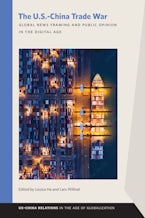Drawing on data from three national surveys, three content analyses, computational topic modeling, and rhetorical analysis, The U.S.–China Trade War sheds light on the twenty-first century’s most high-profile contest over global trade to date. Through diverse empirical studies, the contributors examine the effects of news framing and agenda-setting during the trade war in the Chinese and U.S. news media. Looking at the coverage of Chinese investment in the United States, the use of peace and war journalism frames, and the way media have portrayed the trade war to domestic audiences, the studies explore how media coverage of the trade war has affected public opinion in both countries, as well as how social media has interacted with traditional media in creating news. The authors also analyze the roles of traditional news media and social media in international relations and offer insights into the interactions between professional journalism and user-generated content—interactions that increasingly affect the creation and impact of global news. At a time when social media are being blamed for spreading misinformation and rumors, this book illustrates how professional and user-generated media can reduce international conflicts, foster mutual understanding, and transcend nationalism and ethnocentrism.
ContentsIntroduction: The U.S.–China Trade War as a Case Study of U.S.–China Relations, Louisa Ha and Lars WillnatPart 1. Economic and International ContextsThe China Knot: A Brief History of U.S.–China Trade Relations Leading to the Trade War, Steven Beckman and Stephen J. HartnettChina’s Foreign Direct Investment Expansion: News Coverage of U.S.–China Economic and Security Review Commission Reports, Hamilton BeanNational Images as Integrated Schemas: How Americans and Chinese Think about Each Other and the U.S.–China Trade War, Lars Willnat, Shuo Tang, Jian Shi, and Ning ZhanPart 2. Media Coverage of the Trade War in the United StatesU.S. Television News Coverage of the Trade War: Partisan vs. Nonpartisan Media, Rik Ray and Yanqin LuHow Media Use and Perceptions of Chinese Immigrants and Mainland Chinese Affect Americans’ Attitudes toward the U.S.–China Trade War, Ruonan Zhang, Louisa Ha, and Nicky Chang BiHow News Media Content and Fake News about the Trade War Are Shared on Twitter: A Topic Modeling and Content Analysis, Louisa Ha, Rik Ray, Frankline Matanji, and Yang YangPart 3. Media Coverage of the Trade War in ChinaHow the Chinese News Media Present the U.S.–China Trade War, Peiqin Chen and Ke GuoComparing U.S. and Chinese Media Coverage of the U.S.–China Trade War: War and Peace Journalism Practice and the Foreign Policy Information Market Equilibrium Hypothesis, Louisa Ha, Yang Yang, Rik Ray, Frankline Matanji, Peiqin Chen, Ke Guo, and Nan LyuHow Weibo Influencers and Ordinary Posters Responded to the U.S.–China Trade War, Louisa Ha, Peiqin Chen, Ke Guo, and Nan LyuConclusion: The Roles of Professional and User-Generated Media in Shaping U.S.–China Relations in the Digital Age, Louisa Ha and Lars WillnatContributors

